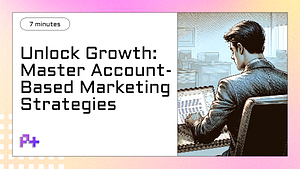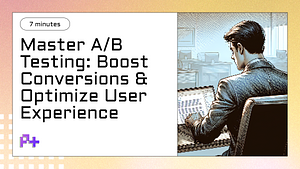Summary
- 1. Understanding Product-Led Growth: What It Means for Your Business
- 2. The Benefits and Challenges of Adopting a Product-Led Sales Approach
- 3. Key Metrics to Measure Success in Product-Led Growth
- 4. Real-World Examples of Successful Product-Led Companies
- 5. Steps to Transition Your Business to a Product-Led Growth Model
1. Understanding Product-Led Growth: What It Means for Your Business
Product-led growth (PLG) is a business strategy that emphasizes the product as the primary driver of customer acquisition, retention, and expansion. This approach contrasts with traditional sales-led models, where sales teams play a central role in driving revenue. In a product-led growth framework, the product itself becomes the key to attracting users, often through free trials, freemium models, or self-service capabilities. Companies that adopt PLG focus on delivering exceptional user experiences, enabling customers to discover, use, and derive value from the product independently. This strategy not only enhances user satisfaction but also fosters organic growth through word-of-mouth referrals and social sharing.
One of the defining characteristics of product-led growth is the emphasis on metrics and feedback loops that prioritize user engagement and product usage. Businesses that embrace PLG often leverage data analytics to understand user behavior, identify pain points, and continually iterate on their offerings. This agile approach allows companies to make informed decisions that enhance the product’s value proposition and align it more closely with customer needs. By prioritizing product development and user experience, organizations can create a self-sustaining growth cycle where satisfied customers become advocates, driving further adoption and market penetration.
Implementing a product-led growth strategy can have significant implications for your business model. It encourages a shift in organizational focus from sales and marketing to product development and user experience. This shift can lead to reduced customer acquisition costs, as satisfied users share their positive experiences with others. Moreover, a product-led approach can streamline onboarding processes and reduce the time it takes for new users to realize value, ultimately boosting retention rates. As the business landscape evolves, understanding and leveraging product-led growth can position your organization for sustainable success in an increasingly competitive market.
2. The Benefits and Challenges of Adopting a Product-Led Sales Approach
Adopting a product-led sales approach can offer numerous benefits that significantly enhance business growth and customer satisfaction. One of the primary advantages is the ability to reduce customer acquisition costs. In a product-led growth (PLG) model, the product itself serves as the primary driver of sales, allowing potential customers to experience its value firsthand before making a purchasing decision. This self-service model not only streamlines the sales process but also fosters trust and loyalty, as customers are more likely to engage with a product that they have already tested and found beneficial. Consequently, businesses can allocate their marketing budgets more effectively, focusing on retention and expansion rather than solely on acquiring new customers.
Despite the compelling advantages, transitioning to a product-led sales approach does come with its challenges. One significant hurdle is the need for a cultural shift within the organization. Teams must embrace a mindset that prioritizes product development and user experience over traditional sales tactics. This requires cross-functional collaboration among product, marketing, and customer success teams to ensure that the product continues to meet user needs and evolves based on feedback. Additionally, companies may struggle with the initial investment in product design and user experience enhancements, which are critical for success in a PLG environment. Ensuring that the product is intuitive and delivers a seamless user experience is essential to driving customer engagement and satisfaction.
Furthermore, measuring success in a product-led growth model can present its own set of challenges. Traditional sales metrics may not fully capture the impact of product usage on revenue generation. Instead, businesses need to focus on key performance indicators such as product adoption rates, user engagement, and customer lifetime value. These metrics provide a clearer picture of how well the product is performing in driving sales and retention. To navigate these challenges effectively, organizations must be willing to invest in analytics tools and customer feedback mechanisms that provide insights into user behavior and preferences. By addressing these hurdles, companies can leverage the benefits of a product-led sales approach to achieve sustainable growth and a competitive edge in their market.
3. Key Metrics to Measure Success in Product-Led Growth
In the realm of product-led growth (PLG), measuring success hinges on specific key metrics that reflect how well a product is driving user engagement, retention, and overall business growth. One of the most critical metrics to consider is the Net Promoter Score (NPS). This score gauges customer loyalty and satisfaction by asking users how likely they are to recommend the product to others. A high NPS indicates that users find value in the product, which often translates into organic growth through referrals and word-of-mouth. Regularly tracking NPS can help companies identify areas for improvement and ensure that they are meeting the evolving needs of their customer base.
Another essential metric in a product-led growth strategy is the Customer Acquisition Cost (CAC). This figure represents the total cost of acquiring a new customer, including marketing expenses and sales efforts. In a successful PLG model, the CAC should be significantly lower than the lifetime value (LTV) of a customer, which is the total revenue a business can expect from a single customer over their relationship duration. By analyzing the CAC in conjunction with LTV, businesses can assess the efficiency of their growth strategies and make informed decisions about resource allocation and customer engagement initiatives.
Finally, the Product Usage Metrics provide invaluable insights into how customers are interacting with the product. Key indicators include daily active users (DAU), monthly active users (MAU), and feature adoption rates. These metrics help businesses understand user behavior, identify which features are most valuable, and determine how often customers return to the product. By closely monitoring product usage, companies can pinpoint opportunities for enhancements, drive user engagement, and ultimately support sustained growth. Together, these metrics create a comprehensive framework for evaluating success in a product-led growth environment, enabling organizations to refine their strategies and foster long-term customer relationships.
4. Real-World Examples of Successful Product-Led Companies
Product-led growth (PLG) has emerged as a powerful strategy for companies looking to drive user acquisition and retention through their products. Several successful companies exemplify this approach, demonstrating how a focus on product quality and user experience can lead to remarkable growth. One notable example is Slack, a collaboration platform that allows teams to communicate efficiently. Slacks growth can be attributed to its user-friendly interface and the ability for teams to start using the product for free. This freemium model encourages users to adopt the tool, which in turn leads to organic growth as users invite colleagues and expand usage within their organizations.
Another compelling case is Dropbox, a cloud storage service that pioneered the product-led growth model in its early days. Dropbox implemented a referral program that rewarded users with additional storage space for inviting friends to join the platform. This not only incentivized users to share the product but also demonstrated the value of Dropbox through direct usage. As users experienced the seamless file-sharing and synchronization features, they became more likely to upgrade to paid plans, driving the company’s revenue growth. The focus on delivering a superior product experience was crucial in establishing Dropbox as a leader in the highly competitive cloud storage market.
Lastly, consider Zoom, a video conferencing software that gained massive popularity, especially during the COVID-19 pandemic. Zooms success can be attributed to its ease of use, high-quality video and audio capabilities, and the ability to host large virtual meetings without complicated setups. The platform initially offered a free tier that allowed users to experience its features before committing to a paid plan. As organizations and individuals turned to remote communication, Zoom became the go-to solution, showcasing how a product-led growth strategy can rapidly scale a company in response to market demand. These examples illustrate that when companies prioritize product excellence and user experience, they can achieve significant growth and establish a loyal customer base.
5. Steps to Transition Your Business to a Product-Led Growth Model
Transitioning your business to a product-led growth (PLG) model involves a strategic shift that centers your product as the primary driver of customer acquisition, retention, and expansion. The first step in this transformation is to reassess your product’s value proposition. Ensure that your product delivers a clear benefit that resonates with your target audience. Conduct thorough market research to understand customer pain points and preferences. This insight will help you refine your product features and ensure that they align with user needs, ultimately making it easier for customers to discover and adopt your product.
Once you have a solid understanding of your products value, the next step is to implement a self-service model. This means creating a seamless onboarding experience that allows users to engage with your product without requiring extensive assistance from your sales team. Invest in intuitive user interfaces and comprehensive educational resources, such as tutorials, FAQs, and community forums, to empower users to explore the product independently. A self-service approach not only enhances user satisfaction but also accelerates the time-to-value, which is crucial in a PLG strategy.
Finally, to support your transition to a product-led growth model, leverage data analytics to drive decisions. Monitor user behavior and feedback to identify areas for improvement and to optimize your product continuously. By analyzing metrics such as user engagement, churn rates, and feature adoption, you can make informed adjustments that enhance the user experience. This data-driven approach will not only help you retain existing customers but also attract new ones by showcasing your product’s effectiveness and adaptability in meeting user needs. Embracing these steps will position your business to thrive in a competitive landscape, making product-led growth a sustainable strategy for long-term success.



